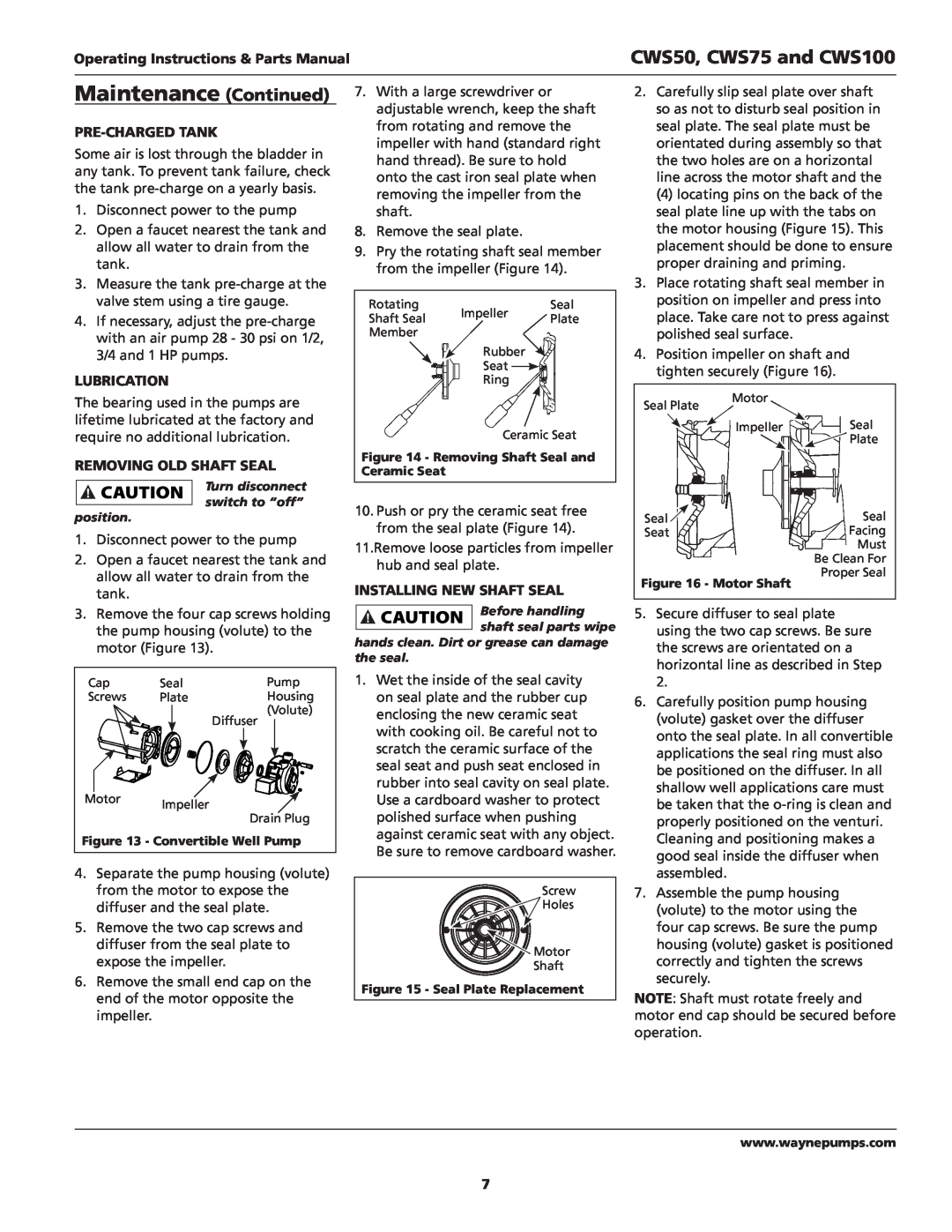
Operating Instructions & Parts Manual | CWS50, CWS75 and CWS100 |
Maintenance (Continued)
PRE-CHARGED TANK
Some air is lost through the bladder in any tank. To prevent tank failure, check the tank
1.Disconnect power to the pump
2.Open a faucet nearest the tank and allow all water to drain from the tank.
3.Measure the tank
4.If necessary, adjust the
LUBRICATION
The bearing used in the pumps are lifetime lubricated at the factory and require no additional lubrication.
REMOVING OLD SHAFT SEAL
Turn disconnect switch to “off”
position.
1.Disconnect power to the pump
2.Open a faucet nearest the tank and allow all water to drain from the tank.
3.Remove the four cap screws holding the pump housing (volute) to the motor (Figure 13).
Cap | Seal | Pump |
Screws | Plate | Housing |
|
| (Volute) |
|
| Diffuser |
Motor Impeller ![]()
![]() Drain Plug
Drain Plug
Figure 13 - Convertible Well Pump
4.Separate the pump housing (volute) from the motor to expose the diffuser and the seal plate.
5.Remove the two cap screws and diffuser from the seal plate to expose the impeller.
6.Remove the small end cap on the end of the motor opposite the impeller.
7.With a large screwdriver or adjustable wrench, keep the shaft from rotating and remove the impeller with hand (standard right hand thread). Be sure to hold onto the cast iron seal plate when removing the impeller from the shaft.
8.Remove the seal plate.
9.Pry the rotating shaft seal member from the impeller (Figure 14).
Rotating | Impeller | Seal | |
Shaft Seal | Plate | ||
| |||
Member |
|
|
Rubber
Seat ![]()
![]()
Ring
Ceramic Seat
Figure 14 - Removing Shaft Seal and Ceramic Seat
10.Push or pry the ceramic seat free from the seal plate (Figure 14).
11.Remove loose particles from impeller hub and seal plate.
INSTALLING NEW SHAFT SEAL
Before handling shaft seal parts wipe
hands clean. Dirt or grease can damage the seal.
1.Wet the inside of the seal cavity on seal plate and the rubber cup enclosing the new ceramic seat with cooking oil. Be careful not to scratch the ceramic surface of the seal seat and push seat enclosed in rubber into seal cavity on seal plate. Use a cardboard washer to protect polished surface when pushing against ceramic seat with any object. Be sure to remove cardboard washer.
Screw
![]() Holes
Holes
![]()
![]()
![]()
![]()
![]()
![]() Motor
Motor
Shaft
Figure 15 - Seal Plate Replacement
2.Carefully slip seal plate over shaft so as not to disturb seal position in seal plate. The seal plate must be orientated during assembly so that the two holes are on a horizontal line across the motor shaft and the
(4) locating pins on the back of the seal plate line up with the tabs on the motor housing (Figure 15). This placement should be done to ensure proper draining and priming.
3.Place rotating shaft seal member in position on impeller and press into place. Take care not to press against polished seal surface.
4.Position impeller on shaft and tighten securely (Figure 16).
Seal Plate | Motor |
|
|
| |
| Impeller | Seal |
|
| Plate |
Seal |
| Seal |
Seat |
| Facing |
|
| Must |
|
| Be Clean For |
Figure 16 - Motor Shaft | Proper Seal | |
| ||
5.Secure diffuser to seal plate using the two cap screws. Be sure the screws are orientated on a horizontal line as described in Step 2.
6.Carefully position pump housing (volute) gasket over the diffuser onto the seal plate. In all convertible applications the seal ring must also be positioned on the diffuser. In all shallow well applications care must be taken that the
7.Assemble the pump housing (volute) to the motor using the four cap screws. Be sure the pump housing (volute) gasket is positioned correctly and tighten the screws securely.
NOTE: Shaft must rotate freely and motor end cap should be secured before operation.
www.waynepumps.com
7
